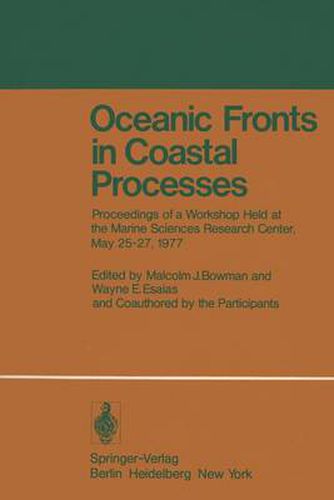Readings Newsletter
Become a Readings Member to make your shopping experience even easier.
Sign in or sign up for free!
You’re not far away from qualifying for FREE standard shipping within Australia
You’ve qualified for FREE standard shipping within Australia
The cart is loading…






This title is printed to order. This book may have been self-published. If so, we cannot guarantee the quality of the content. In the main most books will have gone through the editing process however some may not. We therefore suggest that you be aware of this before ordering this book. If in doubt check either the author or publisher’s details as we are unable to accept any returns unless they are faulty. Please contact us if you have any questions.
On May 25, 1977 a small invited group of coastal oceanographers assembled at the Marine Sciences Research Center at Stony Brook for three days of intensive discussions in a cloistered setting. The purpose of this workshop was to assess the state of the art, to ascertain priorities for future research and to formulate the theoretical, instrumen tal, experimental and logistical tools needed to attain those goals in the study of coastal oceanic* fronts.
Although the existence of oceanic fronts has been known for a long time, ocean frontology is experiencing rapid acceleration in the emergence of new concepts and methodology. The science is developing from the descriptive phase and many unsolved problems lie in the understanding and quantification of frontal dynamics. In turn, challenging questions need to be addressed on the controlling influence of the physics of fronts on the chemistry, biology, acoustics, and suspended particulate aggregations in these zones. Coastal fronts are very efficient at concentrating buoyant and suspended particulate matter inclUding toxic wastes; heavy metal concentrations in polluted coastal frontal zones have been measured to be as high as one to ten thousand times background. These zones are also regions of high biological productivity, and consequently frequented by both commercial and sports fishermen.
$9.00 standard shipping within Australia
FREE standard shipping within Australia for orders over $100.00
Express & International shipping calculated at checkout
Stock availability can be subject to change without notice. We recommend calling the shop or contacting our online team to check availability of low stock items. Please see our Shopping Online page for more details.
This title is printed to order. This book may have been self-published. If so, we cannot guarantee the quality of the content. In the main most books will have gone through the editing process however some may not. We therefore suggest that you be aware of this before ordering this book. If in doubt check either the author or publisher’s details as we are unable to accept any returns unless they are faulty. Please contact us if you have any questions.
On May 25, 1977 a small invited group of coastal oceanographers assembled at the Marine Sciences Research Center at Stony Brook for three days of intensive discussions in a cloistered setting. The purpose of this workshop was to assess the state of the art, to ascertain priorities for future research and to formulate the theoretical, instrumen tal, experimental and logistical tools needed to attain those goals in the study of coastal oceanic* fronts.
Although the existence of oceanic fronts has been known for a long time, ocean frontology is experiencing rapid acceleration in the emergence of new concepts and methodology. The science is developing from the descriptive phase and many unsolved problems lie in the understanding and quantification of frontal dynamics. In turn, challenging questions need to be addressed on the controlling influence of the physics of fronts on the chemistry, biology, acoustics, and suspended particulate aggregations in these zones. Coastal fronts are very efficient at concentrating buoyant and suspended particulate matter inclUding toxic wastes; heavy metal concentrations in polluted coastal frontal zones have been measured to be as high as one to ten thousand times background. These zones are also regions of high biological productivity, and consequently frequented by both commercial and sports fishermen.